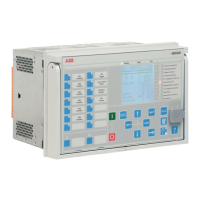Voltage control vs. tap changer moving direction
OLATCC has the control settings
Lower block tap
and
Raise block tap
. The
Lower
block tap
and
Raise block tap
settings should give the tap changer position that
results in the lowest and highest controlled voltage value (usually at the LV side of
the transformer). The setting of both
Raise block tap
value higher than
Lower block
tap
value and
Lower block tap
value higher than
Raise block tap
value is allowed.
When the value of
Raise block tap
exceeds the
Lower block tap
value, the raise
control activates the RAISE_OWN output. This results in raising the tap changer
position, and the measured voltage rises. Furthermore, the RAISE_OWN output
value is TRUE. If the own tap changer position is connected (that is, the own tap
changer's quality is good), the tap changer alarm is activated if the tap changer
does not move upwards in the
Cmd error delay time
setting after the pulse
activation, resulting that ALARM_REAS in the monitored data contains a command
error value. The
Cmd error delay time
setting default value is 20 seconds.
The lowering control works in a similar way, as shown in
Figure 559
. In the output
data, the LOWER_OWN output value is TRUE. An alarm is generated if the tap
changer does not move upwards in
Cmd error delay time
after the pulse activation,
assuming that the own tap changer position is connected.
In the second case, the parameters are set so that the value of
Lower block tap
exceeds the value of
Raise block tap
. The raising control activates the RAISE_OWN
output. The result should be that the tap changer lowers its position and the
measured voltage rises. Furthermore, the RAISE_OWN output value is TRUE in the
output data. If the own tap changer position is connected, the tap changer alarm
is activated if the tap changer does not move downwards in
Cmd error delay
time
after the pulse activation, resulting that ALARM_REAS in the monitored data
contains a command error value.
9.5.4.5 Automatic voltage regulation of single transformer
OLATCC is intended to control the power transformers with a motor-driven on-load
tap changer. The function is designed to regulate the voltage at the secondary
side of the power transformer. The control method is based on a step-by-step
principle, which means that one control pulse at a time is issued to the tap changer
mechanism to move it exactly one position upwards or downwards. However, when
intermediate steps are not indicated for the tap changer, it does not cause alarm if
more than one step change is met.
The purpose of the regulator is to maintain a stable secondary voltage of the power
transformer. The basis for this operation is the
Band center voltage
setting. By
increasing or decreasing various compensation factors, the regulator calculates a
control voltage from the band center voltage as shown in
Equation 184
. Hence, the
control voltage is the desired transformer secondary voltage to be maintained by
the regulator. The control voltage is compared to the measured voltage and the
difference between the two forms the regulating process error.
Since the tap changer changes the voltage in steps, a certain error has to
be allowed. The error, called
Band width voltage
, is also set by the user. A
recommended setting for
Band width voltage
should be close to twice the step
voltage of the transformer ΔU
step
and never below it as a minimum. For example,
Band width voltage
is twice the value of ΔU
step
in
Figure 559
.
If the measured voltage fluctuates within the control voltage ± half the
Band width
voltage
setting, the regulator is inactive. If the measured voltage is outside the
half-bandwidth voltage limits, an adjustable delay T1 (
Control delay time 1
) starts,
Control functions
1MRS757644 H
1050 620 series
Technical Manual

